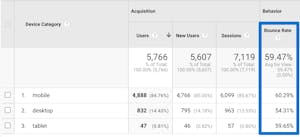- 10 minute read
- SEO
- Websites
All Skill Levels
Get a behind-the-scenes-look into FareHarbor's 2024 season

Keeping users engaged on your website for longer sessions is essential for boosting conversions and improving user experience. If you’ve read our guide on bounce rate and engagement rate in Google Analytics, you know that there are a couple of options for measuring the quality of user sessions on your site.
Bounce rate: Tracked in the original Google Analytics (Universal Analytics), bounce rate is the percentage of all sessions on your site in which users viewed a single page and then immediately left the site. Usually, a high bounce rate signals that users are not finding what they’re looking for on your site, which causes them to go elsewhere to satisfy their search query.
Engagement rate: A new, more in-depth metric used in Google Analytics 4, engagement rate offers a more detailed look at user sessions on your website. It tracks sessions that last longer than 10 seconds, have multiple page views, or result in a conversion.
Whichever metric you’re focusing on, the following tips are all about keeping users on your site longer by improving the content and design, site speed, and other elements that contribute to a positive user experience.
Users form an opinion about your website in a matter of seconds. To keep them on the page, place critical elements (e.g. CTAs, H1, essential content) toward the top of the page so people can instantly see what it’s all about.
Visitors expect the page to match what they see in the SERP. For example, the H1 for the page should match the title tag they saw in their search. Make sure banners, large jumbotron rows, and photos don’t push the important content too far down the page.
 Pro tip: Analyze scroll depth (how far users are scrolling down a web page) using Google Tag Manager to see where users are exiting the page. If the essential information that matches the query is below the exit point, meaning they didn’t scroll far enough to find it, it’s time to redesign the page.
Pro tip: Analyze scroll depth (how far users are scrolling down a web page) using Google Tag Manager to see where users are exiting the page. If the essential information that matches the query is below the exit point, meaning they didn’t scroll far enough to find it, it’s time to redesign the page.
In tandem with positioning the most essential elements above the fold, minimize less important ones, like ads, chat pop-ups, email sign-ups, and similar content that users are less interested in. Too many visual elements can overwhelm readers and increase the likelihood of them bouncing off the page.
There’s nothing more frustrating than landing on a page that won’t load. Not only is site speed a major ranking factor, but it also directly impacts bounce rate. According to Neil Patel:
As page load time goes from 1 second to 3 seconds, the probability of bounce increases by 32%
From 1 second to 5 seconds, it increases by 90%!
If the content on the page matches the search intent, and nothing else seems to be amiss in terms of user experience, site speed might be to blame for a high bounce rate, especially if you’re seeing it across many pages. To decrease page load time, follow the steps in our guide on improving site speed with a Lighthouse audit.
Like we mentioned, whatever you’re advertising on the SERP needs to match what’s actually on the page. In other words, it’s essential to write for search intent. If users land on a page and it has nothing to do with their search query, they’re going to bounce right off in search of a resource that meets their needs.
Additionally, employ methods to make your content easily readable. Use lots of white space, headings, short sentences, bullet points, and images to help users scan the page and quickly find what they’re looking for.
If you’re focusing on a tour or activity page with a high bounce rate, find additional tips in our guide to writing tour descriptions that sell.
Make it easy for people to browse more of your site by using internal links. These links take people from one page on your website to another, which helps direct your audience to additional resources or information that lives on a different page. When you use internal links with actionable anchor text, you make it simple for users to continue their search right on your website.
Confusing navigation can stop users in their tracks. In fact, good site structure is one of our 8 elements of websites that rank and convert. It boils down to your menu and the way users get around your site. If they can’t find the page they’re looking for, they’re sure to bounce. Site structure should be logical and well balanced, with organized categories and user experience in mind.
Did you know you can segment bounce rate in Google Analytics by device? This way, you can see if your bounce rate is higher on desktop or mobile, which offers valuable insights into your site design. Go to Audience > Mobile > Overview to see your bounce rate across devices. If you find that your bounce rate is much higher for mobile or tablet, it indicates that you haven’t optimized your site for those devices. Check out out 11 tips for mobile-first design.

You can further segment bounce rate in Google Analytics based on certain groups of users, since different audiences will have different site browsing behaviors. By getting an understanding of who is more likely to bounce, you can make changes to your content to better target your desired audience.
Here are some ways to assess bounce rate and how to access them in GA:
Decreasing your bounce rate will lead to a more engaged audience and more conversions. Start by choosing one or two of your pages with the worst bounce rate and implement a few of the above changes as necessary to see improvement.
Remember to look beyond the overall site bounce rate and dig into the data on specific pages and audience segments to get the most out of your optimizations. When in doubt, give A/B testing a try for more insight into how your audience engages with your website. For more Google Analytics tips, read this guide on understanding your customers’ paths to conversion.